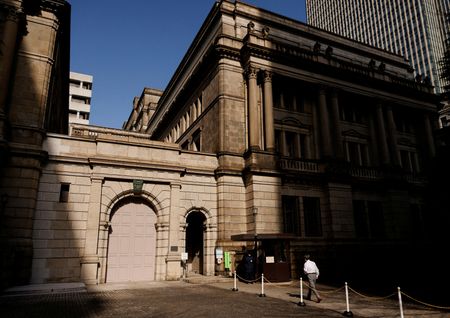LONDON (Reuters) – Major central banks are steadily moving closer to a pause in their aggressive interest rate hiking campaigns.
The U.S. Federal Reserve has just implemented its smallest rise of its tightening cycle so far. The European Central Bank and the Bank of England raised rates on Thursday, but markets suspect a peak is nearing.
Overall, 10 big developed economies have raised rates by a combined 2,965 basis points in this cycle to date, with Japan the holdout dove.
Here’s a look at where policymakers stand, from hawkish to dovish.
GRAPHIC: The race to raise rates The race to raise rates (https://www.reuters.com/graphics/CANADA-CENBANK/dwvkdeaqopm/chart.png)
1) UNITED STATES
The Fed on Wednesday raised its benchmark overnight interest rate by 25 basis points to a range of 4.50% to 4.75%, its smallest hike so far of an 11-month tightening cycle.
Fed Chair Jerome Powell said it would “not be appropriate” to cut rates in 2023 and warned inflation remained too high, pushing back against an exuberant market rally driven by hopes of eventual rate cuts. Powell offered no clues on how many hikes were due this year, saying decisions would be made “meeting by meeting.”
GRAPHIC: Fed keeps promise of more hikes (https://www.reuters.com/graphics/USA-FED/zgpobkryyvd/chart.png)
2) CANADA
The Bank of Canada (BoC) on Jan. 18 lifted its key rate by 25 basis points to 4.5%, the highest level in 15 years.
BoC Governor Tiff Macklem told Reuters he was purely focused on whether borrowing costs should be higher, quashing market bets that cuts could come as soon as October.
Canada’s central bank has raised its policy rate at a record pace of 425 basis points in 10 months. Inflation, which peaked at 8.1% and slowed to 6.3% in December, remains more than triple the BoC’s 2% target.
GRAPHIC: Bank of Canada keeps on hiking Bank of Canada keeps on hiking (https://www.reuters.com/graphics/CANADA-CENBANK/egpbymdakvq/chart.png)
3) NEW ZEALAND
The Reserve Bank of New Zealand (RBNZ) upped its pace of tightening in November, delivering a record 75-basis-point rate rise after five consecutive 50-basis-point rate increases.
Minutes from the meeting showed the RBNZ also considered a larger 100-basis-point hike but opted for a smaller increase. The central bank raised its forecast for its peak interest rate to 5.5%, up from a previous forecast of 4.1%.
GRAPHIC: New Zealand’s record rate hike (https://www.reuters.com/graphics/NEWZEALAND-ECONOMY/lgpdknnlqvo/chart.png)
4) BRITAIN
The BoE, the first major central bank to turn hawkish back in December 2021, on Thursday lifted its Bank Rate for the tenth time running to 4%, the highest since 2008. The BoE dropped a former pledge to keep increasing rates “forcefully” and said UK inflation had probably peaked.
GRAPHIC: BoE’s fight against inflation (https://www.reuters.com/graphics/BRITAIN-BOE/dwpkdeezmvm/chart.png)
5) AUSTRALIA
The Reserve Bank of Australia pushed ahead with a third straight 25-basis-point hike in December, taking its key rate to 3.1%, its highest level in a decade.
Markets have priced in at least two more 25-basis-point rate hikes during this tightening cycle after inflation surged to a 33-year high in the fourth quarter.
GRAPHIC: Taming inflation (https://www.reuters.com/graphics/GLOBAL-MARKETS/THEMES/egpbyaaaevq/chart.png)
6) NORWAY
Norway, which raised the curtain on the hawkish global trend by first raising rates in September 2021, kept its policy rate unchanged at 2.75% on Jan. 19.
In potentially another sign of the future of global rate moves, the Norges Bank also noted inflationary pressures were easing and previous hikes were slowing the economy.
GRAPHIC: Hikes stalled (https://www.reuters.com/graphics/GLOBAL-CENTRALBANKS/jnvwyxxxxvw/chart.png)
7) EURO ZONE
The ECB raised its key rate by 50 basis points to 2.5% on Thursday, its fifth successive hike and the highest level since November 2008.
It said it intends to hike the rate by another 50 basis points in March to bring inflation down to its 2% medium-term target.
While euro zone headline inflation eased for the third straight month in January, falling to 8.5% from 9.2% in December, core inflation held steady at 5.2%.
GRAPHIC: ECB hikes again and signals more to come (https://www.reuters.com/graphics/GLOBAL-CENTRALBANKS/dwpkdeejmvm/chart.png)
8) SWEDEN
Swedish inflation hit a 30-year high of 10.2% on a year-on-year basis in December, raising the pressure on the Riksbank to keep lifting borrowing costs.
Sweden’s central bank hiked its key rate by 75 basis points to 2.5% in November and next meets on Feb. 8
GRAPHIC: Further hikes expected (https://www.reuters.com/graphics/GLOBAL-CENTRALBANKS/lgvdknnkepo/chart.png)
9) SWITZERLAND
The Swiss National Bank (SNB) raised its policy rate by 50 basis points to 1% in December, in its third hike of 2022. Senior officials have signaled further increases could come this year.
SNB Chairman Thomas Jordan said last month that it’s too early to sound the all-clear on inflation, although inflation eased to 2.8% in December from a year earlier.
GRAPHIC: Exit from negative rates (https://www.reuters.com/graphics/CEN-WRAP/znvnbkkjbvl/chart.png)
10) JAPAN
The Bank of Japan, the most dovish major global central bank, inched closer to ending its ultra-easy monetary policy in December with a hawkish tweak to its yield-curve control scheme that it uses to pin down borrowing rates.
The BOJ resisted further policy changes in January. But as inflation rises, the International Monetary Fund has recommended the BOJ let government bond yields move more freely and consider raising short-term interest rates. Any such move may rock markets as Japanese investors sell overseas assets to invest back home.
GRAPHIC: BOJ under fire BOJ under fire (https://www.reuters.com/graphics/JAPAN-ECONOMY/BOJ/zjpqjeoojvx/chart.png)
(Reporting by Yoruk Bahceli, Samuel Indyk, Nell Mackenzie, Dhara Ranasinghe, Alun John, Naomi Rovnick, Harry Robertson and Chiara Elisei; Graphics by Vincent Flasseur, Sumanta Sen and Pasit Kongkunakornkul and Riddhima Talwani; Editing by Paul Simao)


